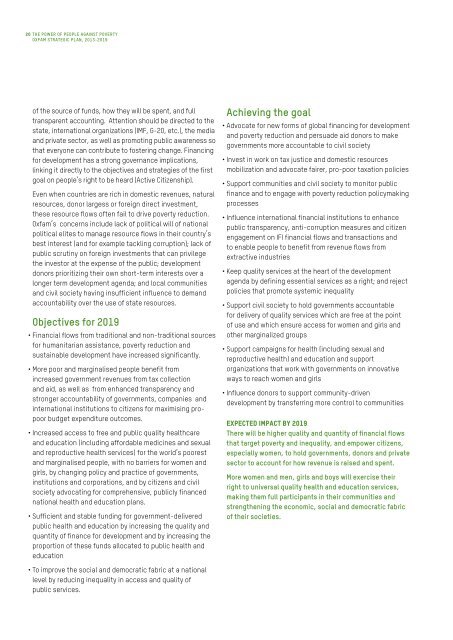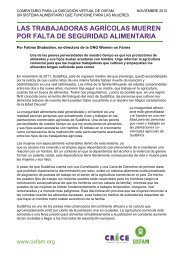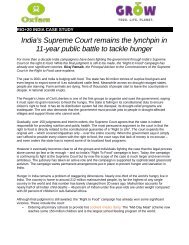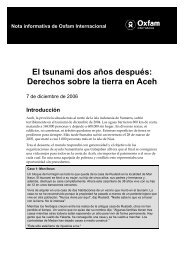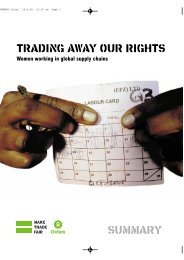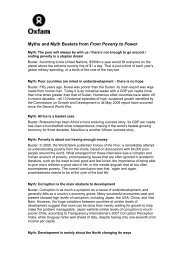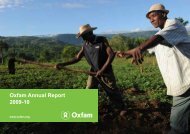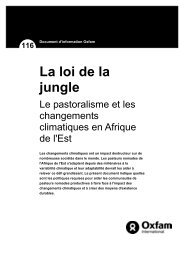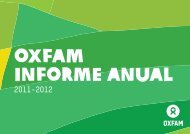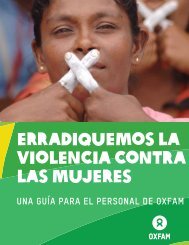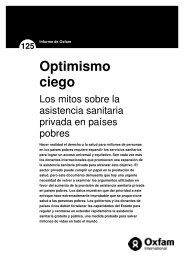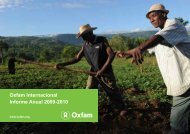Oxfam Strategic Plan, 2013-2019 - Oxfam International
Oxfam Strategic Plan, 2013-2019 - Oxfam International
Oxfam Strategic Plan, 2013-2019 - Oxfam International
You also want an ePaper? Increase the reach of your titles
YUMPU automatically turns print PDFs into web optimized ePapers that Google loves.
20 THE POWER OF PEOPLE AGAINST POVERTY<br />
OXFAM STRATEGIC PLAN, <strong>2013</strong>-<strong>2019</strong><br />
of the source of funds, how they will be spent, and full<br />
transparent accounting. Attention should be directed to the<br />
state, international organizations (IMF, G-20, etc.), the media<br />
and private sector, as well as promoting public awareness so<br />
that everyone can contribute to fostering change. Financing<br />
for development has a strong governance implications,<br />
linking it directly to the objectives and strategies of the first<br />
goal on people’s right to be heard (Active Citizenship).<br />
Even when countries are rich in domestic revenues, natural<br />
resources, donor largess or foreign direct investment,<br />
these resource flows often fail to drive poverty reduction.<br />
<strong>Oxfam</strong>’s concerns include lack of political will of national<br />
political elites to manage resource flows in their country’s<br />
best interest (and for example tackling corruption); lack of<br />
public scrutiny on foreign investments that can privilege<br />
the investor at the expense of the public; development<br />
donors prioritizing their own short-term interests over a<br />
longer term development agenda; and local communities<br />
and civil society having insufficient influence to demand<br />
accountability over the use of state resources.<br />
Objectives for <strong>2019</strong><br />
• Financial flows from traditional and non-traditional sources<br />
for humanitarian assistance, poverty reduction and<br />
sustainable development have increased significantly.<br />
• More poor and marginalised people benefit from<br />
increased government revenues from tax collection<br />
and aid, as well as from enhanced transparency and<br />
stronger accountability of governments, companies and<br />
international institutions to citizens for maximising propoor<br />
budget expenditure outcomes.<br />
• Increased access to free and public quality healthcare<br />
and education (including affordable medicines and sexual<br />
and reproductive health services) for the world’s poorest<br />
and marginalised people, with no barriers for women and<br />
girls, by changing policy and practice of governments,<br />
institutions and corporations, and by citizens and civil<br />
society advocating for comprehensive, publicly financed<br />
national health and education plans.<br />
• Sufficient and stable funding for government-delivered<br />
public health and education by increasing the quality and<br />
quantity of finance for development and by increasing the<br />
proportion of these funds allocated to public health and<br />
education<br />
Achieving the goal<br />
• Advocate for new forms of global financing for development<br />
and poverty reduction and persuade aid donors to make<br />
governments more accountable to civil society<br />
• Invest in work on tax justice and domestic resources<br />
mobilization and advocate fairer, pro-poor taxation policies<br />
• Support communities and civil society to monitor public<br />
finance and to engage with poverty reduction policymaking<br />
processes<br />
• Influence international financial institutions to enhance<br />
public transparency, anti-corruption measures and citizen<br />
engagement on IFI financial flows and transactions and<br />
to enable people to benefit from revenue flows from<br />
extractive industries<br />
• Keep quality services at the heart of the development<br />
agenda by defining essential services as a right; and reject<br />
policies that promote systemic inequality<br />
• Support civil society to hold governments accountable<br />
for delivery of quality services which are free at the point<br />
of use and which ensure access for women and girls and<br />
other marginalized groups<br />
• Support campaigns for health (including sexual and<br />
reproductive health) and education and support<br />
organizations that work with governments on innovative<br />
ways to reach women and girls<br />
• Influence donors to support community-driven<br />
development by transferring more control to communities<br />
Expected impact by <strong>2019</strong><br />
There will be higher quality and quantity of financial flows<br />
that target poverty and inequality, and empower citizens,<br />
especially women, to hold governments, donors and private<br />
sector to account for how revenue is raised and spent.<br />
More women and men, girls and boys will exercise their<br />
right to universal quality health and education services,<br />
making them full participants in their communities and<br />
strengthening the economic, social and democratic fabric<br />
of their societies.<br />
• To improve the social and democratic fabric at a national<br />
level by reducing inequality in access and quality of<br />
public services.


